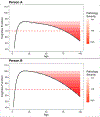Cognitive Aging and Dementia: A Life Span Perspective
- PMID: 34046638
- PMCID: PMC8153102
- DOI: 10.1146/annurev-devpsych-121318-085204
Cognitive Aging and Dementia: A Life Span Perspective
Abstract
This article summarizes empirical findings and theoretical concepts in cognitive aging and late-life dementia research. Major emphases are placed on (1) person-to-person heterogeneity in trajectories of cognitive change over time, (2) how trajectories of child cognitive development determine peak levels of adult cognitive function from which aging-related cognitive declines occur, and (3) how lifelong trajectories of cognitive function relate to the timing of severe cognitive impairments characteristic of dementia. I consider conceptual issues surrounding categorical vs. dimensional models of late-life dementia, and how current diagnostic approaches affect inferences in the empirical study of disease progression. The incomplete current understanding of the biological foundations of aging-related cognitive declines and the continuous nature of many biomarkers commonly used in dementia diagnosis and classification together pose both opportunities and challenges in the current research landscape. Research moving forward will benefit from accurately measuring and analyzing continuous variation in longitudinal trajectories of cognitive function.
Keywords: Alzheimer’s Disease; Cognitive Aging; Cognitive Reserve; Dementia; Longitudinal; Neurocognitive.
Figures






References
-
- American Psychiatric Association. (2013). Diagnostic and statistical manual of mental disorders (5th ed.). Washington, DC: Author.
-
- Baltes PB (1987). Theoretical propositions of life-span developmental psychology: On the dynamics between growth and decline. Developmental Psychology, 23(5), 611.
-
- Baltes P, Reese HW, & Nesselroade JR (1977). Life-span developmental psychology: Introduction to research methods. Monterey, CA: Brooks.
-
- Baltes PB, & Schaie KW (1974). The myth of the twilight years: Intelligence does not slide downhill from adulthood through old age. Psychology Today, 8, 35–40.
Grants and funding
LinkOut - more resources
Full Text Sources
